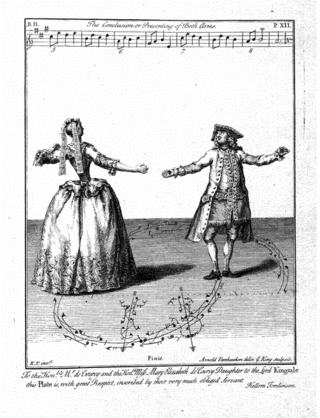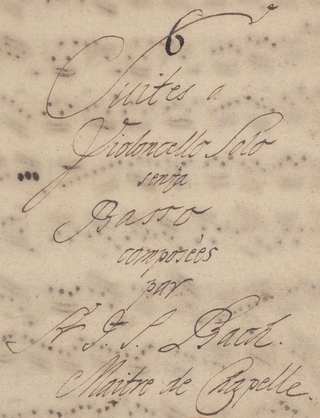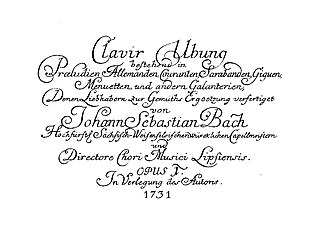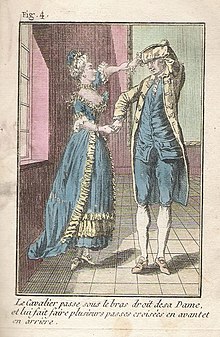
Baroque dance is dance of the Baroque era, closely linked with Baroque music, theatre, and opera.

The waltz is a ballroom and folk dance, in triple, performed primarily in closed position. Along with the ländler and allemande, the waltz was sometimes referred to by the generic term German Dance in publications during the late 18th and early 19th centuries.

A suite, in Western classical music, is an ordered set of instrumental or orchestral/concert band pieces. It originated in the late 14th century as a pairing of dance tunes; and grew in scope so that by the early 17th century it comprised up to five dances, sometimes with a prelude. The separate movements were often thematically and tonally linked. The term can also be used to refer to similar forms in other musical traditions, such as the Turkish fasıl and the Arab nuubaat.

The Ländler is a European folk dance in 3
4 time. Along with the waltz and allemande, the ländler was sometimes referred to by the generic term German Dance in publications during the late 18th and early 19th centuries. Despite its association with Germany, the ländler was danced in many European countries. Composers from a variety of European nations wrote music for the ländler dance; including Austria, Switzerland, Bohemia, Moravia, Slovenia and northern Italy in addition to Germany.

The rondo is a musical form that contains a principal theme which alternates with one or more contrasting themes, generally called "episodes", but also occasionally referred to as "digressions" or "couplets". Some possible patterns include: ABACA, ABACAB, ABACBA, or ABACABA.

The six Cello Suites, BWV 1007–1012, are suites for unaccompanied cello by Johann Sebastian Bach (1685–1750). They are some of the most frequently performed solo compositions ever written for cello. Bach most likely composed them during the period 1717–1723, when he served as Kapellmeister in Köthen. The title given on the cover of the Anna Magdalena Bach manuscript was Suites à Violoncello Solo senza Basso.
John Jenkins (1592–1678), was an English composer who was born in Maidstone, Kent and who died at Kimberley, Norfolk.

Historical dance is a term covering a wide variety of Western European-based dance types from the past as they are danced in the present. Today historical dances are danced as performance, for pleasure at themed balls or dance clubs, as historical reenactment, or for musicological or historical research.

The gavotte is a French dance, taking its name from a folk dance of the Gavot, the people of the Pays de Gap region of Dauphiné in the southeast of France, where the dance originated, according to one source. According to another reference, the word gavotte is a generic term for a variety of French folk dances, and most likely originated in Lower Brittany in the west, or possibly Provence in the southeast or the French Basque Country in the southwest of France. It is notated in 4
4 or 2
2 time and is usually of moderate tempo, though the folk dances also use meters such as 9
8 and 5
8.

The sarabande is a dance in triple metre, or the music written for such a dance.
Johann Caspar Ferdinand Fischer was a German Baroque composer. Johann Nikolaus Forkel ranked Fischer as one of the best composers for keyboard of his day; however, partly due to the rarity of surviving copies of his music, his music is rarely heard today.

The Partita in D minor for solo violin, BWV 1004, by Johann Sebastian Bach, was written between 1717 and 1720. It is a part of his compositional cycle called Sonatas and Partitas for Solo Violin.
The courante, corrente, coranto and corant are some of the names given to a family of triple metre dances from the late Renaissance and the Baroque era. In a Baroque dance suite an Italian or French courante is typically paired with a preceding allemande, making it the second movement of the suite or the third if there is a prelude.

The English Suites, BWV 806–811, are a set of six suites written by the German composer Johann Sebastian Bach for harpsichord and generally thought to be the earliest of his 19 suites for keyboard, the others being the six French Suites, the six Partitas and the Overture in the French style. They probably date from around 1713 or 1714.

The French Suites, BWV 812–817, are six suites which Johann Sebastian Bach wrote for the clavier between the years of 1722 and 1725. Although Suites Nos. 1 to 4 are typically dated to 1722, it is possible that the first was written somewhat earlier.
Pierre Février was a French baroque composer, organist and harpsichordist.

The term galanteries is sometimes used for movements in the Baroque dance suite whose inclusion is variable, unlike the fixed core of allemande, courante, sarabande and gigue. These pieces usually follow the sarabande.
Ennemond Gaultier (c. 1575 – 17 December 1651) was a French lutenist and composer. He was one of the masters of the 17th century French lute school.

Baroque music refers to the period or dominant style of Western classical music composed from about 1600 to 1750. The Baroque style followed the Renaissance period, and was followed in turn by the Classical period after a short transition. The Baroque period is divided into three major phases: early, middle, and late. Overlapping in time, they are conventionally dated from 1580 to 1650, from 1630 to 1700, and from 1680 to 1750. Baroque music forms a major portion of the "classical music" canon, and is widely studied, performed, and listened to. The term "baroque" comes from the Portuguese word barroco, meaning "misshapen pearl". The works of Johann Sebastian Bach and George Frideric Handel are considered the pinnacle of the Baroque period. Other key composers of the Baroque era include Antonio Vivaldi, Domenico Scarlatti, Claudio Monteverdi, Alessandro Scarlatti, Alessandro Stradella, Tomaso Albinoni, Johann Pachelbel, Henry Purcell, Georg Philipp Telemann, Jean-Baptiste Lully, Jean-Philippe Rameau, Marc-Antoine Charpentier, Arcangelo Corelli, François Couperin, Johann Hermann Schein, Heinrich Schütz, Samuel Scheidt, Dieterich Buxtehude, Gaspar Sanz, José de Nebra, Antonio Soler, Carlos Seixas, Adam Jarzębski, Jan Dismas Zelenka, Heinrich Ignaz Franz Biber and Giovanni Battista Pergolesi.
The German Dance, also known as Deutsche, Deutscher Tanz and Teutsche, was a generic term utilized in the late 18th and early 19th centuries for partner dances written in triple metre. These encompassed several different types of dances, including the waltz, ländler, and allemande. Composers of German Dances frequently wrote and published them in sets of three, six, or twelve for use at balls. Many composers published sets of Deutsche, including Joseph Haydn, Wolfgang Amadeus Mozart, Ludwig van Beethoven, and Franz Schubert to name a few.














